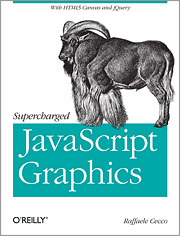- Author: Raffaele Cecco
- publisher: O’Reilly Media
- pages: 280
Introduction
A pleasant book written by an author with lots of experience. The examples are fun, and realistic. The tempo of the book is easy to follow for intermediate JavaScript developers.
Review
I like that the book begins with a DHTML example, this makes the reader really understand the fact that building the web is possible with many tools and that each tool has its cons and pros. The newest toys ( canvas, webgl etc ) aren’t necessarily the best or the fastest to build a proper user experience. In the beginning of the book the reader get acquainted with; the browser landscape, sprites, framerates and best practices for working with the DOM which is a pain for performance. The code examples are clear and luckily without excessive comments, which makes the example easy to read for the more experienced developers which are books target group.
The next chapters concern page enhancing techniques like scrolling effects, ui-libraries and shows the best way to create user interface elements form scratch. Al these chapters are a fine introduction for the more performance hungry subjects of games.
The second part of the book dicusses games, staring with a DHTML version of space invaders. This game example incorporates a lot previeous learned techniques en demonstrates the power and performance of well used DHTML.
Of course the power of the newer toys are easy to see with the examples in the book for example the ( recursive ) tree example is a brilliant example of the performance of the canvas element. The bigger part of this book emphasizes on the canvas element. The book clearly demonstrates the posibillities and raw power of the element.
The following chapters cover mobile javascript graphics, phonegap and the Google Charts API.
At first the mix of topics seemed strange to me, however the chapter were really fun to read and I will definitilly use Google Charts in upcoming projects if needed. jQuery Mobile is equally interesting, though personally I would probably take a more responsive way in the future with embedding the touch events into a global library for websites.
Bottom line
this book definitely is a fun read supported by excellent examples for medior to advanced javascript developers who develop applications at his moment, the author makes use of contemporary, but proven libraries and API’s . Which is a plus these days with swift innovation cycles.
The books product page

